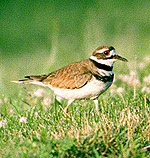


Killdeer |
Those of us living in central Illinois can't imagine our state having much habitat for shorebirds. In fact, Lake Michigan, in northern Illinois attracts a fair number of interesting species, most often during spring and fall migration. In central Illinois, shorebirds are most often found where receding water levels give way to tempting mudflats and beaches where food can be found. |
The killdeer is Illinois' most common shorebird. It can be seen most anywhere, even along a country road. The "killdeer" call makes identification easy. You may have seen a mother killdeer with a drooping wing feign injury in an attempt to lure you away from her nest on the ground. She hopes that the predator will see a potentially injured bird as an easier meal and leave her babies alone. |
|
Ruddy turnstones are most likely to be seen at Lake Michigan during migration. The migrate from the arctic regions to the gulf and Atlantic coasts. They may travel as far south as South America. |
||
 |
 |
 |
| American Avocets regularly work as a team to find food. They are often seen sweeping their bills from side to side as they wade through water up to their undersides. | Sightings of the Willet seem to be on the increase in Illinois. They pass through Illinois during migration, wintering in the southeastern U.S. and farther south to South America. | The Hudsonian Godwit is seen in Illinois only occasionally. It travels from its arctic breeding ground as far south as Chile and Tierra del Fuego. |
 |
 |
 |
| The semipalmated plover looks like a killdeer, except that it has only one ring around the neck area. Watch it run before it stops to pick up a morsel of food. | The piping plover is on both the state and federal endangered species lists. Increased recreational use of beaches by vehicles is one of the reasons for its decline. | In Illinois, the black-bellied plover is most commonly seen along the shores of Lake Michigan. |
 |
 |
|
| The Lesser (American) golden plover blends in with the tilled farm fields it frequents in search of grubs and other insect treats. Due to an elliptical shaped migration pattern, goldens are most likely to be seen in Illinois during the spring. | Short-billed dowitchers are difficult to tell from their relatives the long-billed dowitchers. Short-bills usually arrive later during spring migration, showing up in May after the long-billed dowitchers have moved on. Many naturalists use such a process of elimination to help narrow down possible identifications. Knowing which birds should be here at certain times of year can be a big help. | |
 |
|
 |
| Long wings help birdwatchers identify the Baird's sandpiper. While they usually pass to the east or west of Illinois, some juveniles regularly find their way to the state. | The spotted sandpiper is a common summer resident, especially in the northern part of the state. They are usually found alone or in small groups away from other shorebirds. | The buff-breasted sandpiper is sometimes found on the beaches of Lake Michigan. They have also been found on sandbars in the Mississippi River. |
 |
 |
 |
| The pectoral sandpiper easily blends in to flooded, grassy areas making detection difficult. It is a common shorebird seen during migration as it travels between the Arctic and southern South America. | The solitary sandpiper is true to its name as it usually hunts for food by itself. Suitable habitat may attract a handful of birds, however. | In addition to quickly picking insects off the mud, the Wilson's Phalarope feeds by swimming and spinning in shallow water. This behavior can be helpful in identification. |
 |
 |
|
| The common snipe is found in a variety of wet habitats, even roadside ditches. It probes in the mud with its long bill as it searches mostly for earthworms to eat. | Unlike most shorebirds, we can find the American woodcock at the edge of the woods. Their mating ritual at dusk and dawn involves flying high into the air, singing and gently returning to the ground. Listen for the nasal "peeent" sound before the display flight. |
